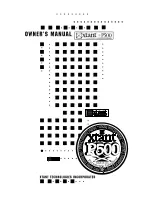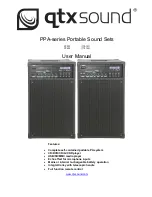
Front Panel Description
1. BYPASS 1, 2, 3 & 4.
Pressing any button toggles between Bypass and Active modes (LED on = Bypass).
2. STORE.
Pressing this control transfers the contents of Working Memory into Stored Memory at a location selected by
either the number keys or the UP/DOWN buttons. Pressing STORE once prompts the user for the Stored Memory location;
pressing it again writes the information to Stored Memory.
3. OL 1, 2, 3 & 4.
Ch.’s 1, 2, 3 & 4 overload (OL) indicators. These red LEDs illuminate any time the inputs, filters or out-
puts of the channels reach 4 dB below clipping.
4. EQUALIZER Display.
This numeric green LED display indicates the boost/cut level of an individual filter, or the over-
all level, whichever is selected (LED on). The MPE 47 must be in the EQ Edit mode to activate this display.
5. EQ.
Pressing this button once places the MPE 47 in the Channels 1-2 EQ Edit mode (CHANNELS 1-2 LED on); a
second depression enters the Channel’s 3-4 EQ Edit mode (CHANNELS 3-4 LED on); and a third time takes the MPE 47
out of the EQ Edit mode (both LEDs off).
6. LEVEL/ EXPRESS.
In the EQ Edit mode, this button allows setting the overall level of either channel. When not in the
EQ Edit mode, this button sets Expression parameters. Expression is a mode that allows an EQ curve to “bend” (change)
based on MIDI continuous controller or channel pressure aftertouch commands. Please see the MPE Users Guide for fur-
ther information.
7. 50Hz/BANK.
In the EQ Edit mode, this button selects the 50 Hz filter. In the Normal Operating mode, pressing this
control locks the MPE to the current bank; something similiar to a “tens hold” function. When using the octal numerical
base system of notation instead of the decimal numerical base system of notation (explained in the MPE Users Guide) it has
a similar function.
8. 125Hz/100/OCTAL A/B.
In the EQ Edit mode, this button selects the 125 Hz filter. In the Normal Operating mode this
gets you directly to the 100s, or switches between A/B banks when using the octal numerical base system of notation.
9. Filters/Numerals.
In the EQ Edit mode, these buttons select the filters associated with their labels. In the Normal
Operating mode they allow direct access number entry for Stored Memory selection. They also select several “secret” fea-
tures when used with the FUNCTION button. To find out more about their other uses, please see the MPE Users Guide.
10. 12.5kHz/FUNCTION.
In the EQ Edit mode, this button selects the 12.5 kHz filter. In the Normal Operating mode it
acts as a shift-key to select secondary functions. Again we must reference the MPE Users Guide for details. Sorry.
11. UP & DOWN.
Used to increase or decrease parameters in all operating modes.
12. SYSTEM Display.
This red digital display indicates system information, such as Stored Memory locations, MIDI Chan-
nel selection, mapping assignments, lockout codes, Factory preset numbers, ramp step size, revision number, and so on.
13. MEMORY.
Used to enter the Normal Operating mode. A flashing LED indicates Working Memory differs from
Stored Memory. When in the EQ Edit mode, all changes to the Working Memory are compared with the Stored Memory
version by simply pressing and holding the MEMORY button. What is heard is the Stored Memory curve; releasing the
MEMORY button allows you to hear edited Working Memory.
14. MIDI CHANNEL.
Pressing this button displays the current MIDI Channel assignment for this MPE. Flashing indicates
MIDI OMNI mode is on. Change the MIDI Channel by using the UP/DOWN buttons, or number keys. Pressing this button
again returns the unit to Normal Operating mode.
15. MAP.
Used for MIDI Mapping covered in the MPE Users Guide.
Summary of Contents for MPE 47
Page 5: ......























